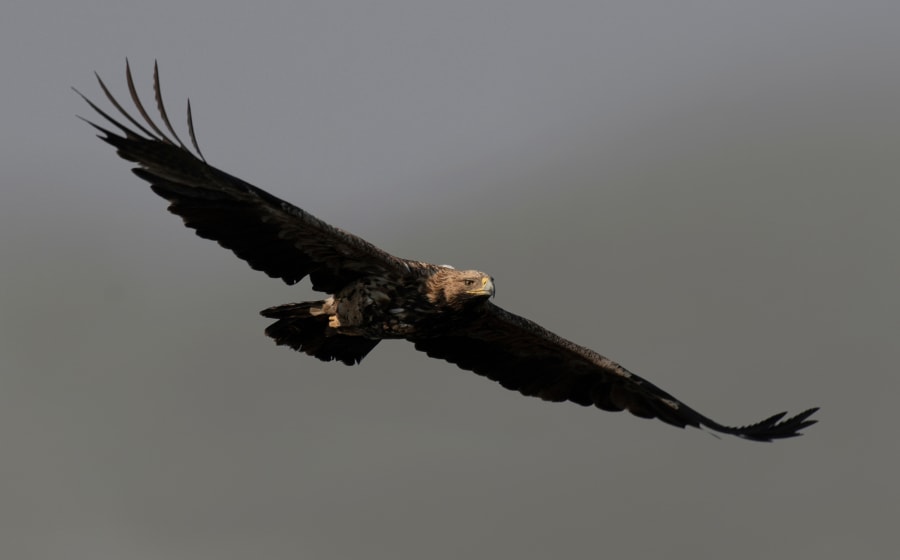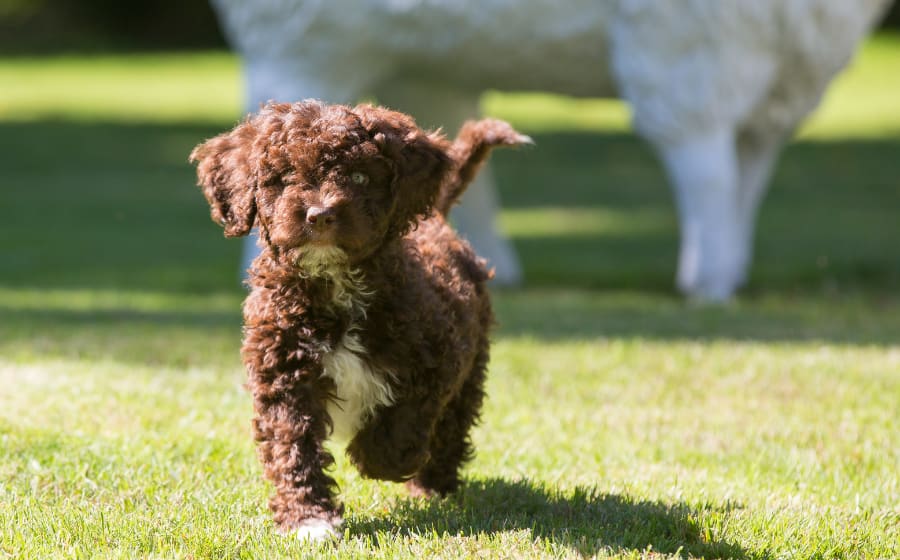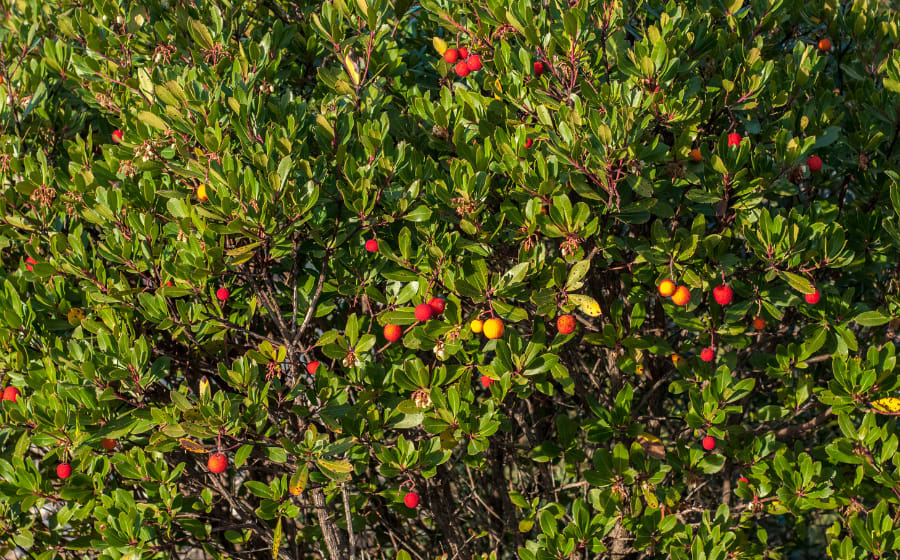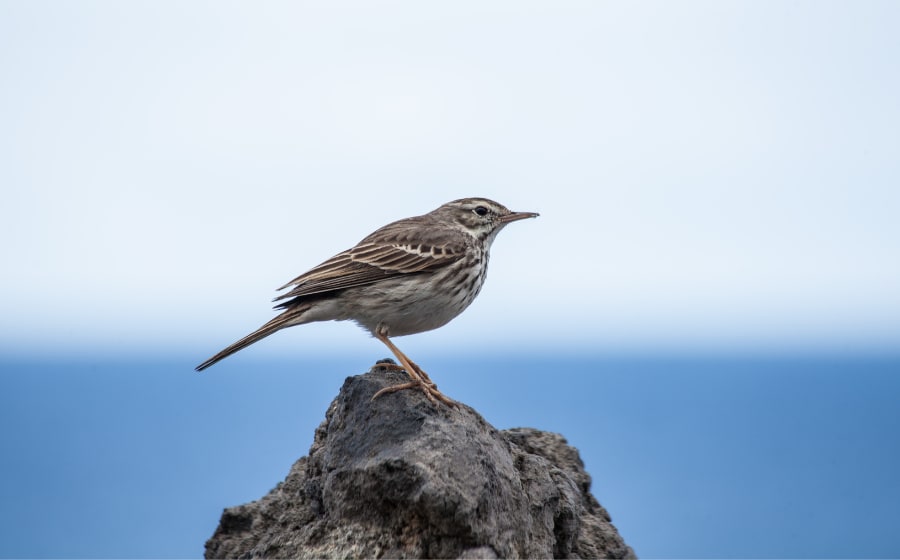Exploring the Spanish Wildlife and Its 11 Emblematic Animals
November 3, 2022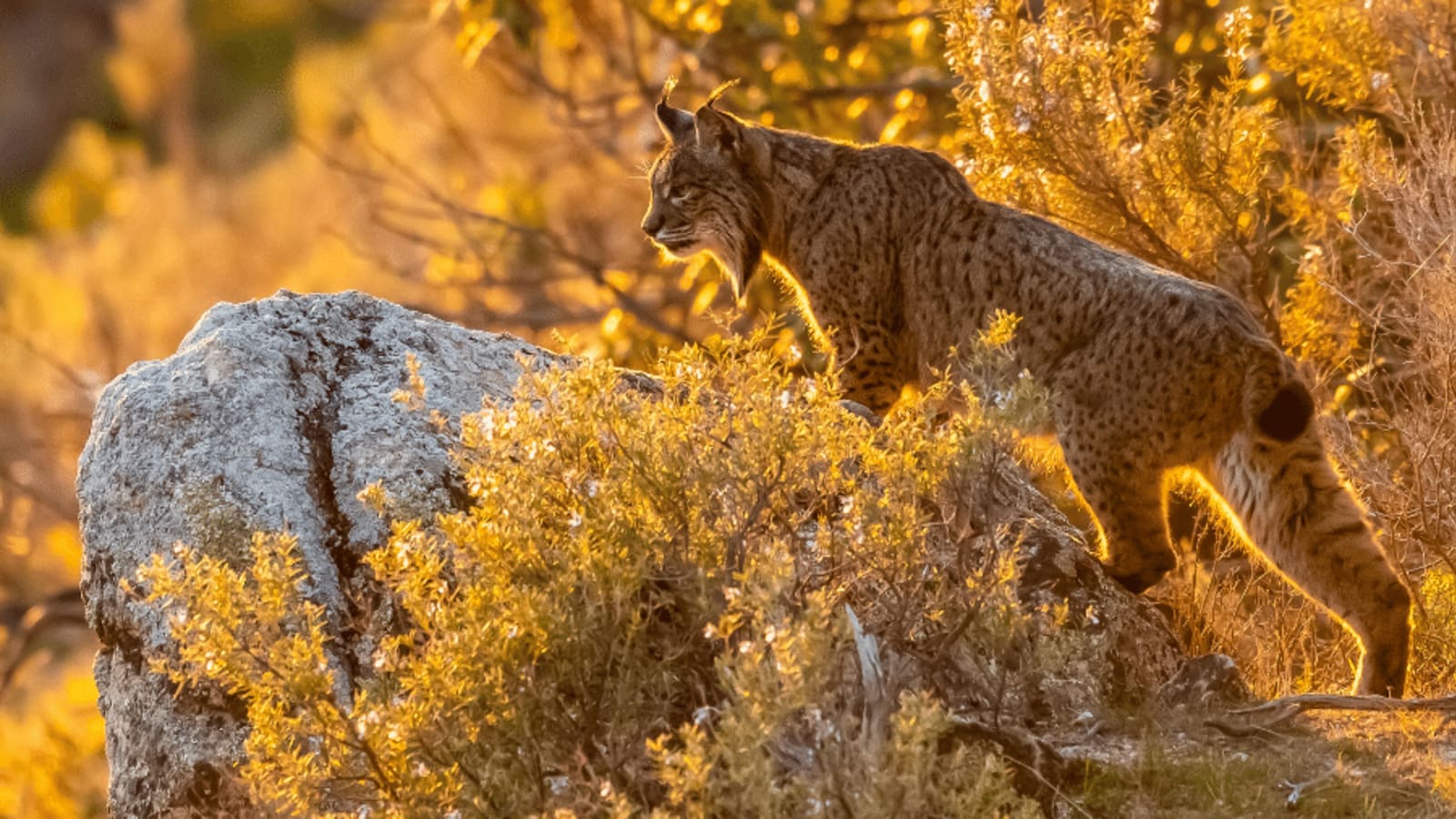
Win a FREE Trip to Spain!
Exciting Announcement! For the first time, we're thrilled to offer exclusive trips to the heart of Spain - an experience like no other. This isn't your typical tourist journey; it's a unique opportunity to immerse yourself in authentic Spanish culture, alongside real locals and our passionate team.
But there's more! Simply by requesting information about this amazing trip, you'll be entered into a special draw to win a Fully Paid Trip to Spain for Two. And that's not all - everyone who inquires will receive an exclusive bonus gift, valued at $500, available only now.
Ready to Discover the Real Spain?Click Here ↑ to Request Information & Enter the Draw!
Yes, Spain has other important animals besides the iconic Bull. Wildlife in this country is so diverse and unique that it is becoming more necessary every day to spread awareness about our endemic and protected species to preserve them.
Respect and appreciation for the environment drive me to show you the absolute best animals in Spain that represent us as a country. Here you’ll find our beloved and preserved endangered species and some of the most incredible wildlife living in our forests, mountains, and countryside.
It would be awesome if you familiarize yourself with the locations we’ll discuss in this article to understand these animals’ environments and climate! I recommend you read these posts first:
- The 9 Best Forests in Spain to Get Lost in The Wild
- The 16 Spanish National Parks and Their Breathtaking Views
- What is the climate in Spain? Our Real Weather and Temperature
But, in case you’re ready to begin our safari, grab your stuff because we’re getting into the wild!
Table of Contents ▼ ▶
1. Iberian Linx, Lince Ibérico
Lynx pardinus
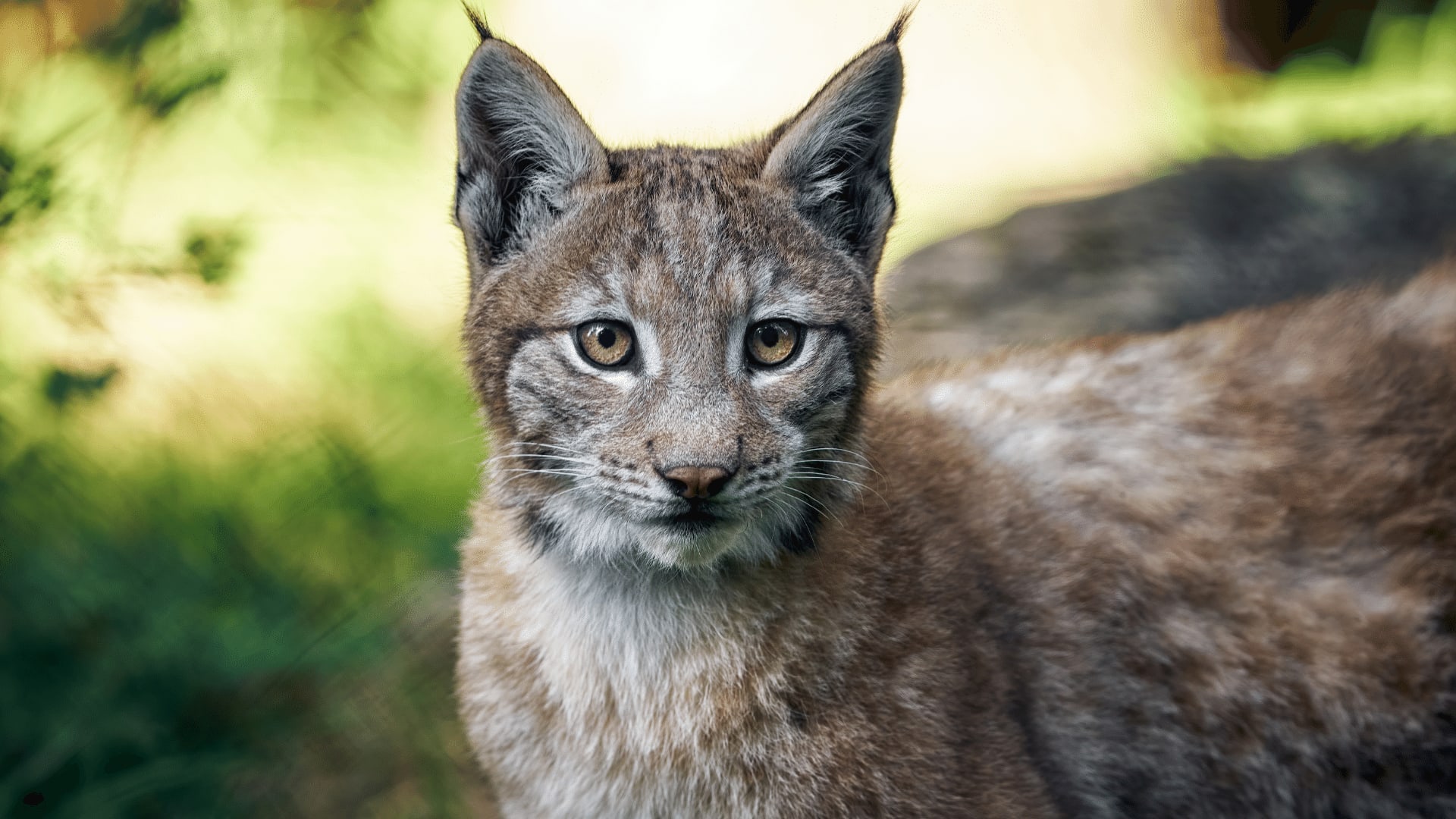
Let’s begin our journey with one of the most threatened felines on the planet, which is also an emblematic specie of the Iberian Peninsula.
The Iberian Lynx can be found in the Mediterranean forest of Portugal, Extremadura, Castilla-La Mancha, and Andalucia. They choose these habitats to be surrounded by abundant scrubs and zones with lots of dams. The Lynx has an unmistakable robust appearance, with long legs and a short tail with a black tassel at the end -which he usually flaps upright in times of danger. His ears have characteristic brushes made up of stiff black hairs, and his hair has a color that varies from brown to greyish.
This specie is significantly declining due to hunting by non-selective methods, such as traps and snares, but especially by the decline of its main prey species, the wild rabbit. Moreover, intentional and involuntary abuse of the specie by human beings by using illegal and non-selective hunting techniques and poaching is a common threat to the Iberian lynx, which has been a great predator.
However, the Lynx is internationally known for its recovery from being critically endangered in the early 21st century. More than 400 live in freedom nowadays thanks to conservation and reintroduction programs.
This specie is very important since it helps select the healthiest specimen and is a great predator. It plays a controlling role in the abundance of mesopredators, such as the fox and the mongoose. In addition, thanks to its presence, there is more awareness for conserving protected areas and forests, positively impacting biodiversity in Spain.
2. Spanish Imperial Eagle, Águila Imperial Ibérica
Aquila adalberti
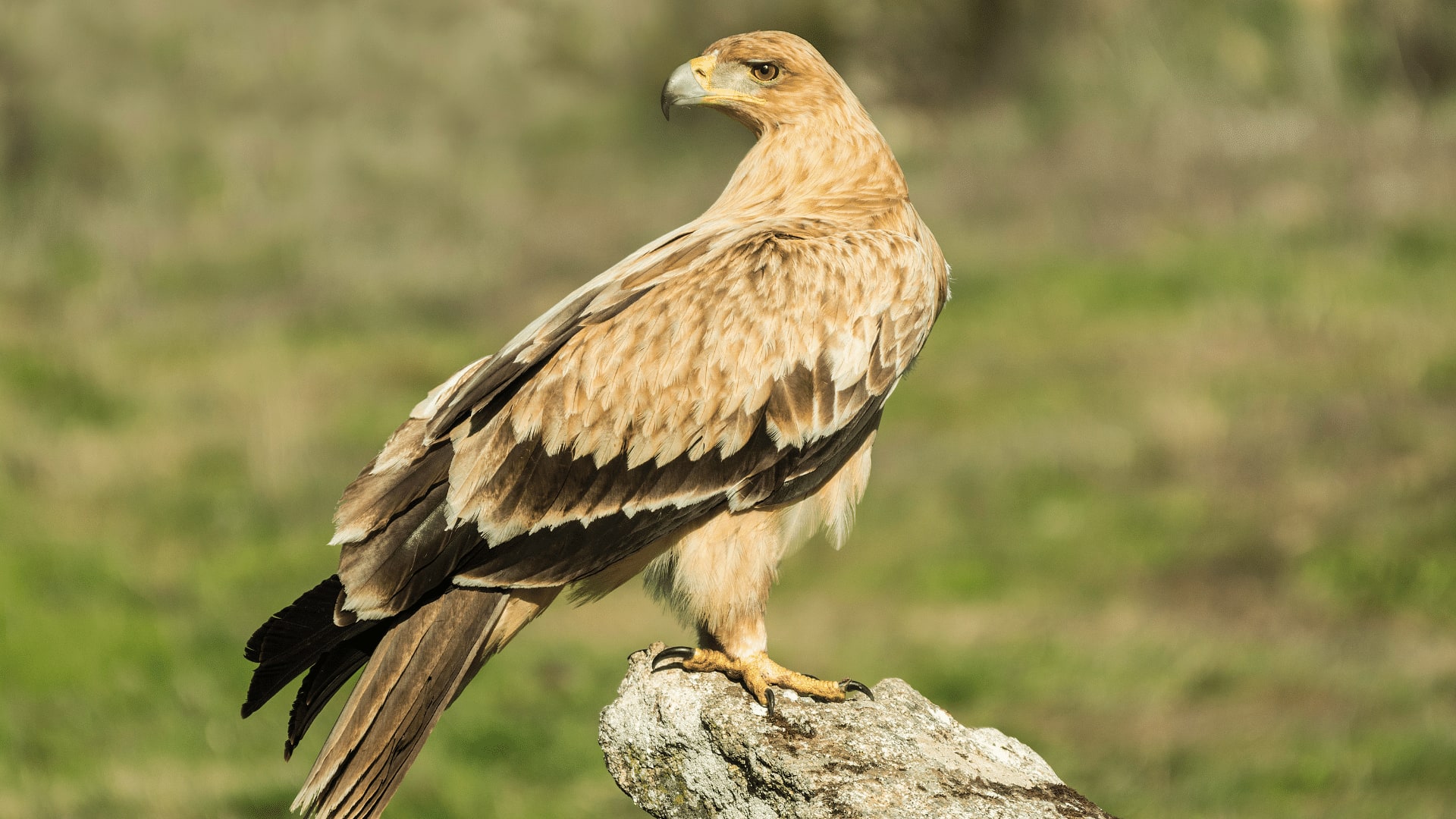
The Spanish Imperial Eagle is one of the Endemic Birds of the Iberian Peninsula. Adults are characterized by their dark brown coloration, except for some parts such as the nate, which has a yellowish ocher coloration, and the “shoulder” feathers, which are white. Their food consists of rabbits, which they hunt alone or in pairs. The eagle also preys on hares, pigeons, ravens, and other birds -and to a lesser extent, foxes and small rodents, and it is enormous since it has a length of about 70 – 80 cm and a wingspan that can reach two meters.
If you’re wondering where to find it, then you can’t miss this post: Top 9 Spanish Eagles: The “Imperial Eagle” is a Beauty! Here I have maps that geographically locate the eagle!!
This species is known for being threatened. It was in danger of extinction due to poisons, electrocution, and direct human persecution. Also, the scarcity of rabbits (their main prey), habitat deterioration, fragmentation, pollution, and diseases are other reasons they’re endangered. However, it is curious to know that at the beginning of the 20th century, the Iberian imperial eagle was still abundant in much of its range. Still, in recent decades its numbers have plunged.
Although it is still in danger, Spanish administrations ensure that this symbol of the Iberian fauna stays in the country. Since the early 1990s, it has doubled thanks to many recovery plans developed by some Autonomous Communities that are home to the bird and have also created their own conservation strategies.
Unlike the eastern imperial eagle of Eurasia and East Africa, this one does not migrate. Each pair defends its hunting and breeding area throughout the year. You can find the Imperial Eagle in habitats such as pine forests in mountain areas, dune systems, and marshes in coastal areas. Their highest densities are reached on flat land or with gentle relief, significant tree formations, and enough rabbit populations so they can hunt!
And where is this? to the southwest of the Iberian Peninsula. In Spain, it lives in the Central System, Montes de Toledo, Extremadura, Cádiz, Mountain Ranges, and Doñana National Park. Oh, and by the way, you won’t believe what they’ve found in this National Park… I have a whole article dedicated to this, and I think you’ll like it:
The Ancient Spanish Lost City: Is the Missing Atlantic in Andalucia?
3. Iberian Hare, Liebre Ibérica
Lepus granatensis
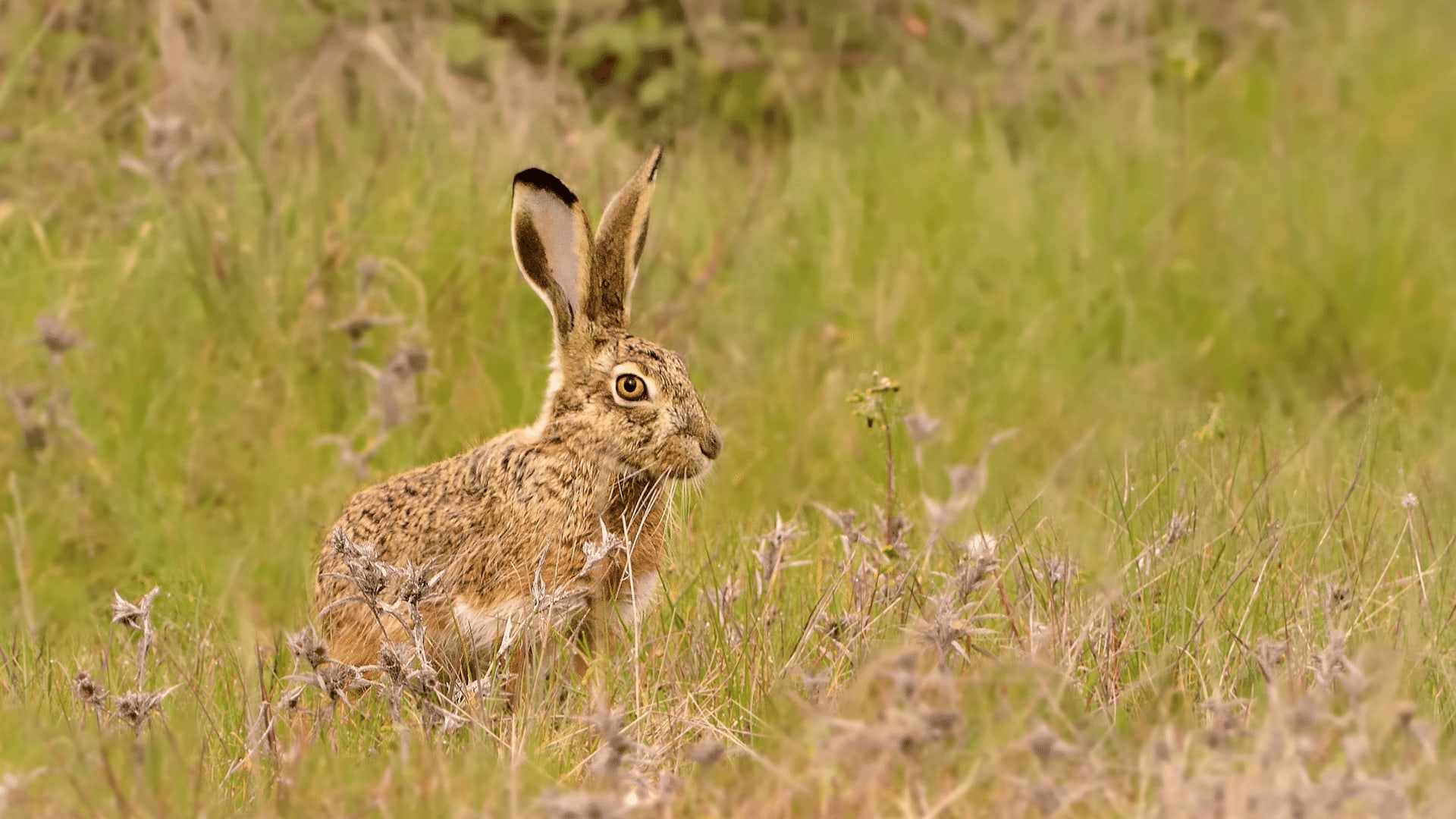
Moving on to the little Iberian Hare, another endangered species of the Peninsula which can be found in the south of the Cantabrian coast, the Ebro valley, and in Mediterranean Galicia. This species loves being outdoors and has developed hearing and smell, with sight being its worst sense. It shows a preference for open spaces and plains, herbaceous or scrub plains, and is also not uncommon in cultivated fields. It feeds mainly on grasses, roots, bulbs, bark, and wild fruits.
Its hair is short and reddish-brown, with black shreds on the back and white on the snout, cheeks, and ventral region, whose dirty white tone extends over the front and rear legs, forming a white band. The tips of the long ears are black, as is the back of the tail. It is the smallest of all hares in Spain and doesn’t have more than 40 centimeters in length, weighing about 2.5 kilograms, while its tail measures about 10 centimeters, more or less like the ears.
Oh, and let me tell you that this little hare is speedy and agile. It can reach a top speed of 70 km/hour since it has a very light skeleton, large hind legs, and a highly developed circulatory system that allows it to pump oxygen at high speed. The hare is also highly suspicious and cautious while also being attentive to what is happening around it, so it never goes directly to “bed” to mislead possible predators and dilute its trail, making sudden turns and changes in the direction of its path. Then, it takes a big jump when it is close to its refuge, placing itself in the opposite direction to the one carried in the march. The main threats to the Iberian hare, in addition to human impact, are wolves, foxes, wildcats, owls, and eagles.
As I mentioned, it likes to live in open but varied spaces. We can find it in the west of Asturias and humid Galicia, where it lives in meadows, fields, and forests; in Mediterranean Galicia, near mountain areas and cultivation areas; in the sub-Cantabrian moors of the north of León, Palencia, and Burgos and Segovia, etc.
4. Iberian Pig, Cerdo Ibérico
Sus scrofa domestica
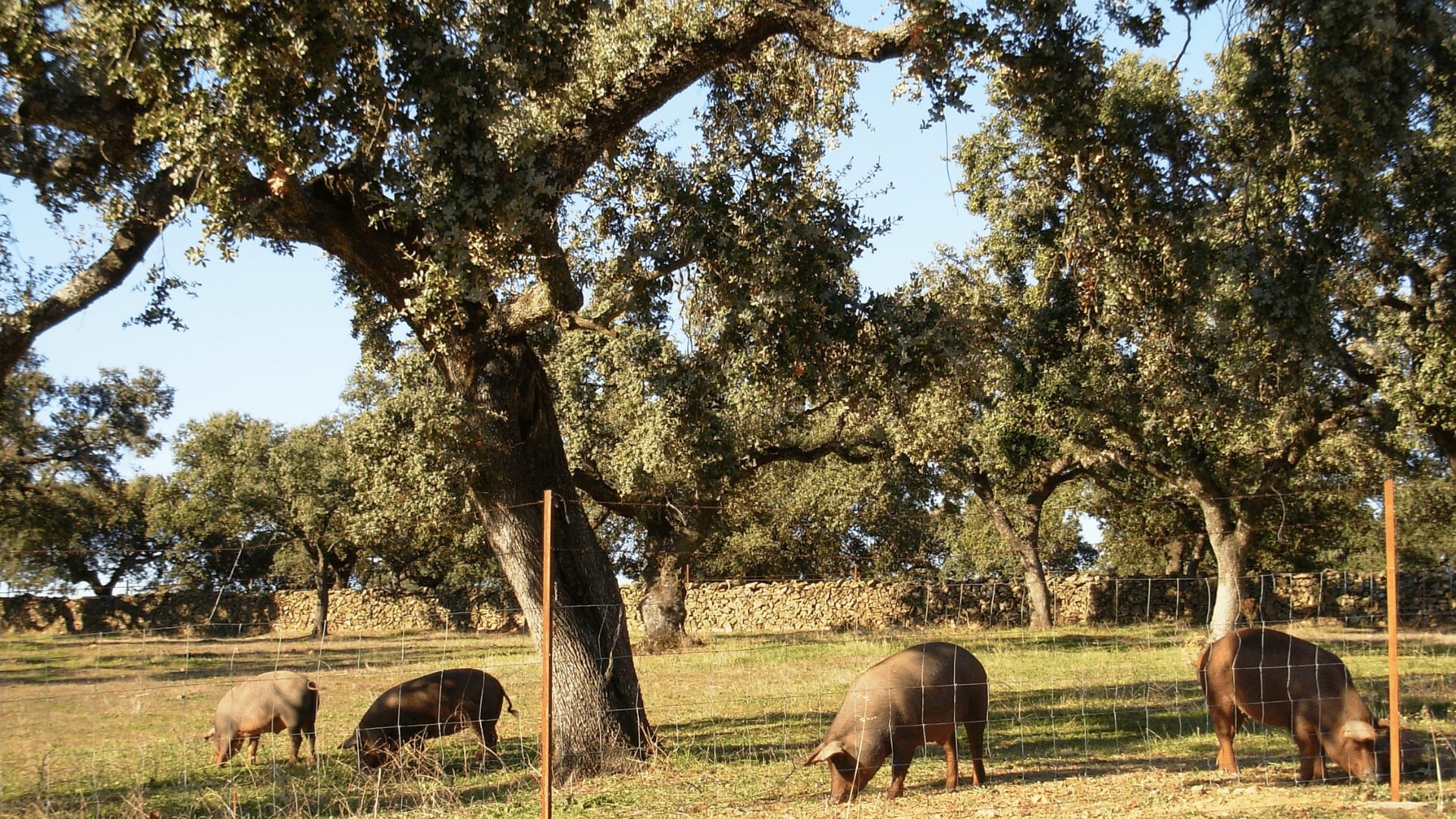
The Iberian pig is an autochthonous breed, exclusive to the Iberian Peninsula, which is raised only in some regions of Spain and Portugal, unlike the white or ordinary pig (raised all over the world).
The primary quality that differentiates this breed from the rest is its physiologic capacity to store fat between muscles, which means that products elaborated from its meat have well-known infiltrations of grease or streaks, enhancing its aroma, flavor, and texture.
Since its origins, the Iberian pig breed has been linked to extensive production systems. They have a very high gastronomic value, and the most outstanding of all of them is undoubtedly the Iberian ham, the most representative product of our history and gastronomic culture.
Three varieties of pigs are in danger of extinction: Torbiscal, Manchado de jabugo, and Lampiño.
- The Ibérico Lampiño variety is one of the native pure Iberian breeds in danger of extinction. As its name indicates, this variant characterizes by being hairless. (in Spanish, lampiño) Its absence of hair leaves numerous skin folds visible, especially in the frontal region, and we can find the pig mainly in Cáceres, Badajoz, and Córdoba.
- The Torbiscal Iberian Pig is another autochthonous breed of pure Iberian in danger of extinction. This one is reddish and can turn gold or copper depending on the sunlight on its skin. One of its unique features is its large drooping ears and a small white depigmentation mark on the hoof of some specimens, which makes breeders doubt its purity. (making this one of the main reasons farmers stopped looking at this breed).
- The third breed is Manchado de Jabugo, originally from Andalucia, and is, together with the Cadiz golden pig, one of the Iberian breeds of which there are fewer copies. Its meat is highly valued and boasts the highest retail price in the world among the Iberian selection. One of its distinguishing features is having irregular black spots spread throughout its body, and it has two sub-varieties of Jabugo: Retinta and Jara. The skin color of the first one is darker, and some of the specimens may have a white hoof, while the other is lighter and dirty white.
The Iberian pig is part of the Spanish wildlife and adds significant value to the country’s gastronomy while being one of the most distributed products throughout the Peninsula.
5. Iberian Wolf, Lobo Ibérico
Canis lupus signatus
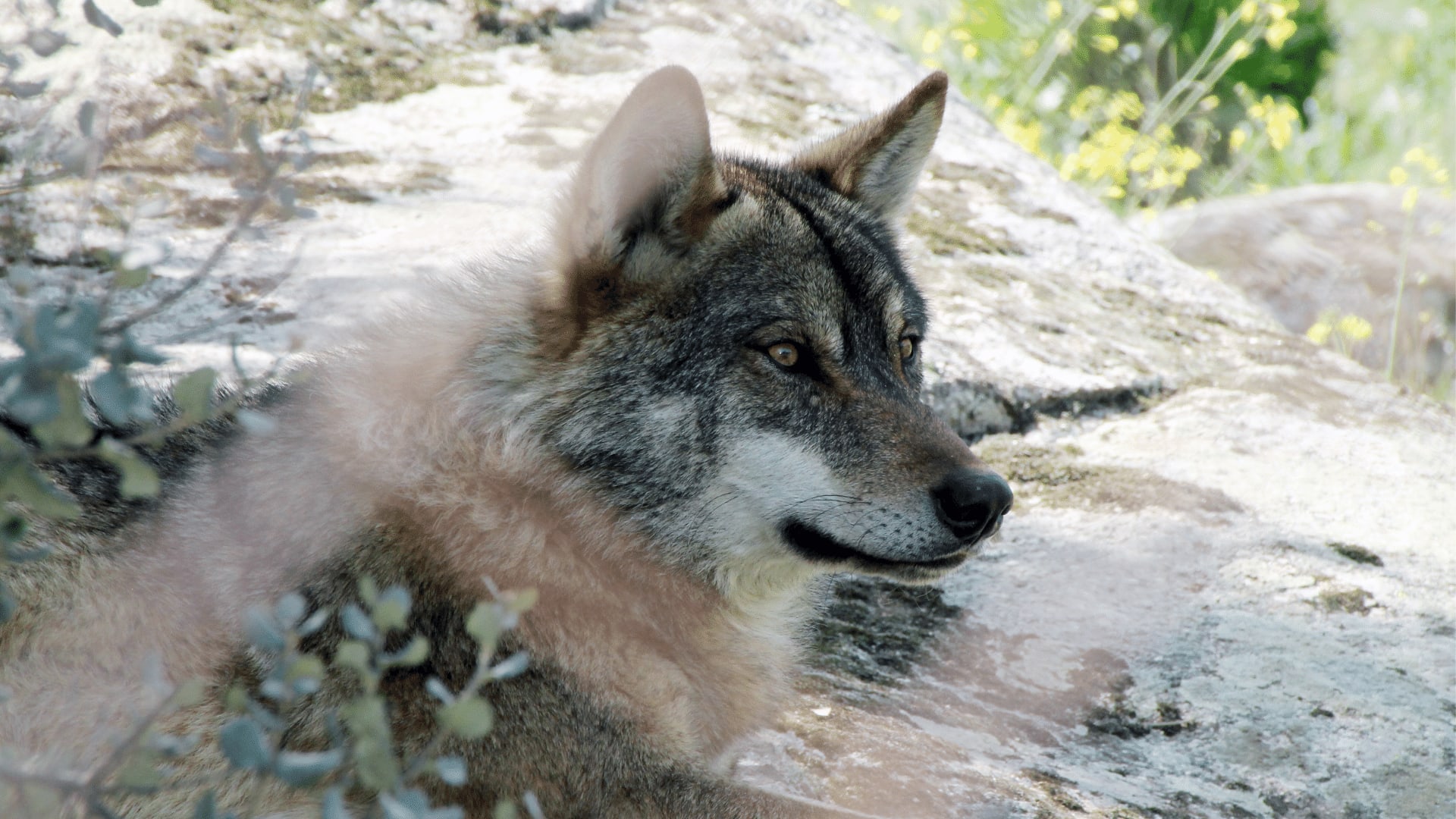
The mighty Iberian Wolf lives between extremes, and part of that ambiguous and contradictory life is due to its physical power. The signatus subspecies (the one existing in our Peninsula) differs in that it has two blackish stripes on the front legs and on the back of the tail. They have incredible eyesight, clearly perceiving distances and relief, acute hearing, and a great sense of smell. Females differ from males by a graceful constitution, sharper snout, and finer tail.
The Iberian wolf was recently included in the “List of Wild Species under a Special Protection Regime” according to the ministerial order. They called out all places with wolf populations in the country to safeguard with the same level of protection that, until now, only wolfs located in the south of the Duero had.
It feeds mainly on large vertebrates such as horses, deer, roe deer, and fallow deer, and it occasionally eats small or medium-sized animals such as rabbits and rodents. However, he will not pass on fruits such as berries, grapes, and figs. Moving on, we can find the wolf in habitats such as Tundra, taiga, temperate and rain forests, and grasslands. In places like Castilla y León, Galicia, Cantabria, and Asturias. And there are also smaller populations in mountain areas in nearby areas such as the Basque Country, La Rioja, and Guadalajara.
As we can see, the Iberian wolf loves Northern Spain cities!! We also treasure the views, landscape, and biodiversity it has to offer. Find out everything about it in this post:
Cities in Northern Spain: 12 locations and best spots to visit
7 Different And Incredible Landscapes You Will Find in Spain
The wolf is the wild species with the most outstanding historical and cultural links with humans. It symbolizes the wild and is a cultural reference of the first order with vast stories, legends, myths, and children’s stories.
And, if you didn’t know, wolves are the ancestors of our current domestic dogs. There is a logical resemblance, although the differences are notable since the wolf is stronger, more vigorous, and resistant, while all its senses are more efficient.
In Spain, we have our own breeds of dogs that we can regularly see strolling down the streets and guarding the beloved rural houses in the Spanish countryside. I had no idea these dogs were 100% native to Spain, but they are!! Find out here:
6. European Mink, Visón Europeo
Mustela lutreola
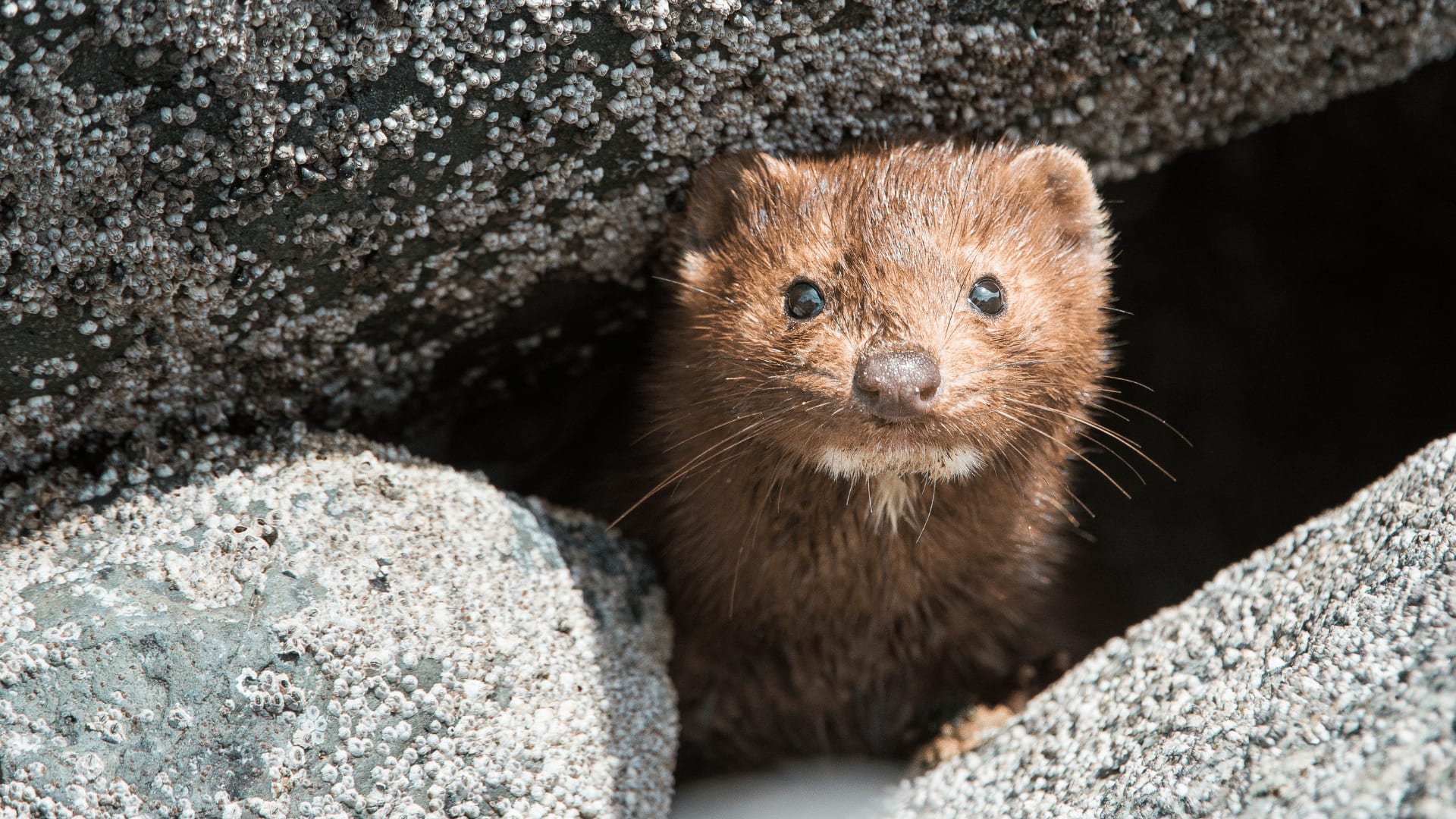
The tiny European Mink is a small-sized carnivore with semi-aquatic habits of uniform brown color, with white lips. His ears protrude slightly on his head, which is big and relatively flattened. His eyes are also small and set slightly apart. We can distinguish it from the American Mink because this one does not have a white upper lip, is larger, and has a darker color.
Its habitat is about 2,500 square kilometers in Cantabria, the Basque Country, Navarra, La Rioja, and Burgos. The European Mink roams the banks of all streams, looking for small prey (both on land and in water). They have a varied carnivorous diet, including fish, small mammals, crabs, amphibians, reptiles, birds, and other invertebrates. Its presence in the rivers goes unnoticed since it is solitary and nocturnal.
Spain and France have become true strongholds of the European Mink after it became extinct in Central and Northern Europe. For this reason, it is included in the endangered species catalog and labeled “endangered.” However, it is vital to preserve him since he is an indicator of the quality of rivers. If this species disappears, it is a sign that our rivers and our ecosystems lack good health.
Estimations say there are less than 500 specimens left, its population continues to decline, and it has already disappeared from 90% of its original range. Most experts indicate that its critical situation is due to the competition with the American Mink, the pollution of rivers, and the loss of its natural habitat.
7. Mountain Goat, Cabra Montesa
Capra pyrenaica
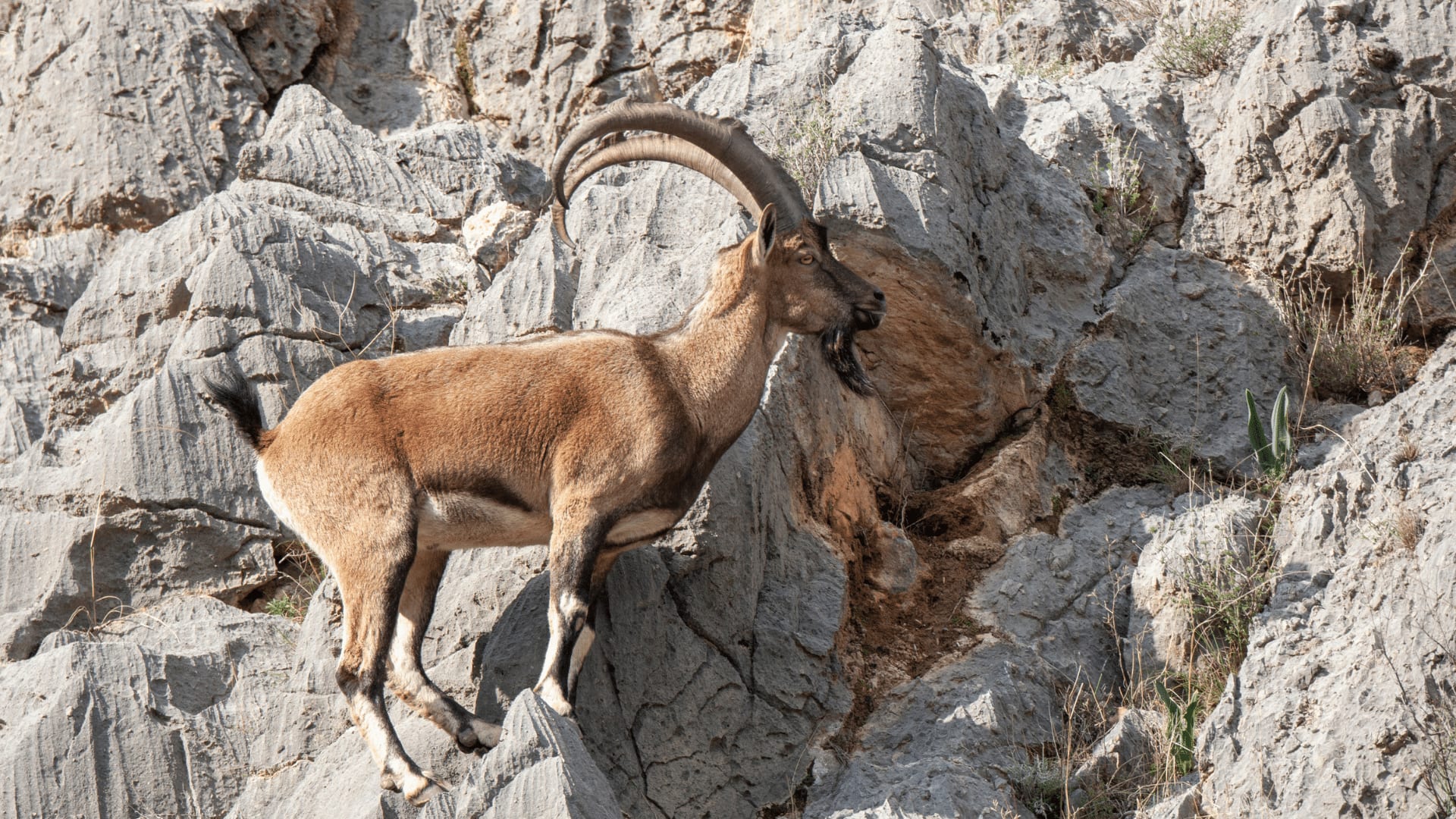
Is this animal easy to see in real life here in Spain? Besides being a unique species from the Iberian Peninsula, you’ll be surprised to know that the Mountain Goat is also relatively easy to see as they are tolerant of human presence and will often come to roads and even towns if left undisturbed. Many people and hunters travel to our country to see or hunt this species in areas such as Gredos or Sierra Nevada, where they easily approach hikers.
These Mountain Goats are well-known for their weird eyes, and this “disconcerting” feature is due to the horizontal position of the pupil, which is deep black and allows you to have a panoramic view of your surroundings. Thanks to it, the goat can easily detect predators. They always live in rocky environments, so they are able to flee and take refuge at high speed in inaccessible places or climb to food that other herbivores do not reach. Their populations distribute along the Sierra de Gredos in Ávila; Puertos de Tortosa-Beceite, in Catalonia; the Madrid mountains, and the southern and eastern mountains, such as the Sierra Nevada, Malaga mountains, and Cazorla. As we can see, they live in forests and thickets of high and medium mountains.
As for their habits, they are fundamentally diurnal and sedentary. In summer, it spends the main hours of the day resting and sheltering from the sun, while in winter, they make longer journeys in search of shelter and shelter, descending to lower areas. It has a highly developed sense of smell, sight, and hearing.
Although it is not an endangered species, one of its main problems is maintaining the purity of the breeds as two subspecies exist in the Iberian Peninsula, making it essential to avoid an uncontrolled transfer of specimens from one area to another. Another problem is caused by epizootics, particularly those infected by domestic livestock, causing them to have scabies and harming the population.
8. Iberian Brown Bear, Oso Pardo
Ursus arctos pyrenaicus

The Iberian Brown Bear is the largest land animal of all Iberian fauna!! Its body is extremely robust, with males being much heavier than females. However, compared to other bears in the world, they are the smallest since males rarely exceed 200 kg and females around 85 or a maximum of 140 kg. Yet, they have considerable variations in weight throughout the year depending on the abundance or scarcity of food.
The few brown bears that live freely in Spain are hard to find. However, they occasionally approach Asturian villages when honeycombs, meadows, or groves with berries are nearby. Their population spreads around Spain, mainly along the Cantabrian Mountain Ranges in Northern Spain. They locate in places like Galicia, Asturias, and Castilla y León. At the same time, just a few of them have been found, more specifically, in areas around the beech forests of Somiedo, Degaña, Monasterio de Hermo, Fuentes Carrionas reserve, and the mountains of Palencia.
Their diet is based on fruits and vegetables, which is very different from other species like the polar bear. This omnivorous animal only opts for carrion meat when it does not find other food around it. Therefore, the brown bear “deceives” everyone in this regard by presenting claws more typical of a carnivorous species than a vegetarian one. The fur coloration of Iberian bears varies from pale cream to dark brown, but always with a peculiar darker coloration, almost black, on the legs and yellowish on the tips of the hairs, while the eyes and the end of his nose are black.
This giant animal currently enjoys a lower risk of extinction due to the tightening of environmental legislation and the change in the relationship between humans and animals. The brown bear is now perceived as a resource that attracts tourism, and people currently respect and value them.
The most common way to know if an Iberian Brown Bear is close to you is to you is by looking at the traces and marks they leave behind.
9. Mediterranean Monk Seal, Foca Monje
Monachus monachus
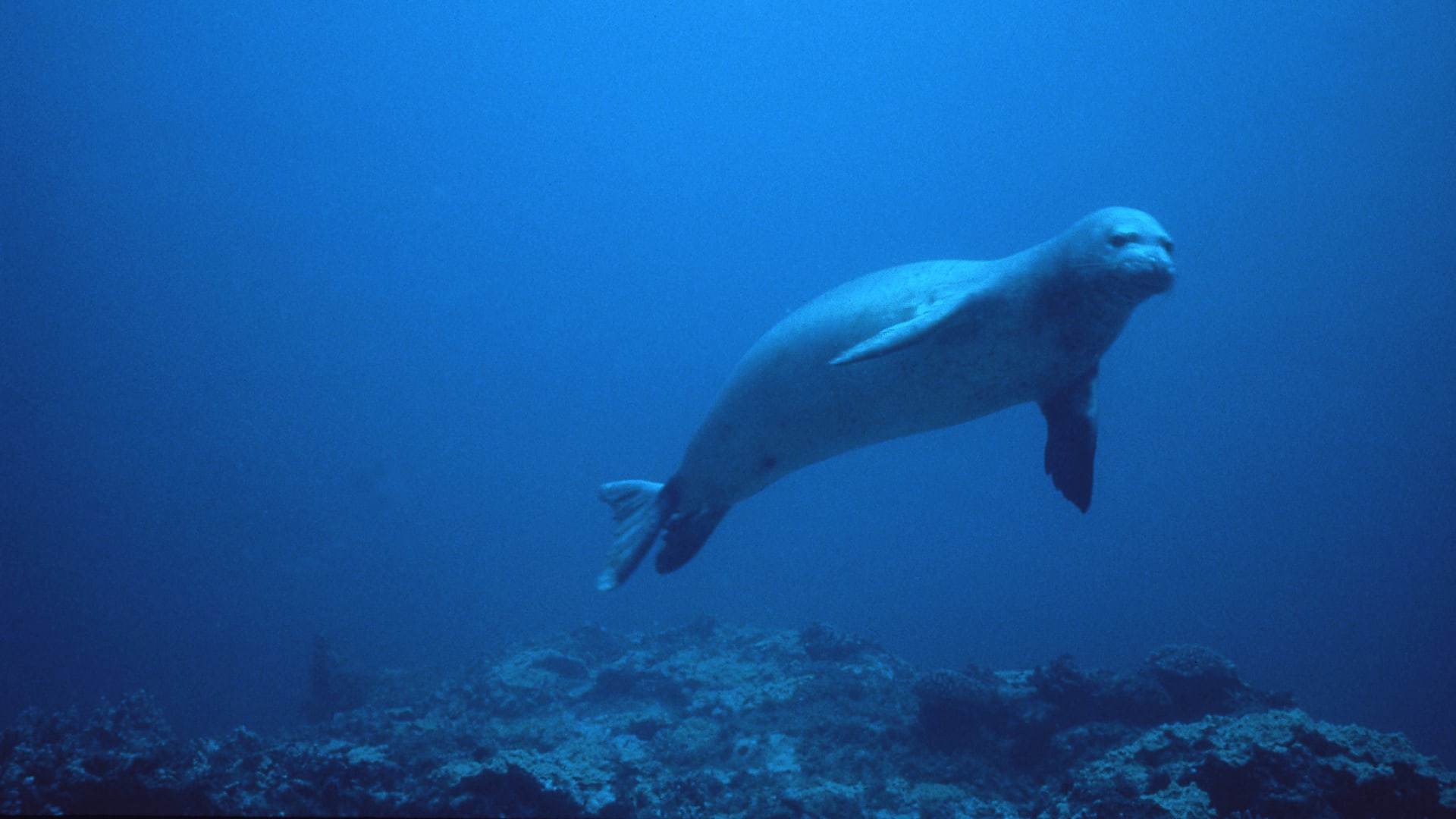
The Mediterranean monk seal (also known as the Mediterranean friar seal) is a mammal in danger of extinction. In the past, specimens could be seen throughout the Mediterranean area. Still, it is increasingly challenging to find large groups, and it is only possible to locate a couple of individuals in the Chafarinas Islands. It has a robust body, rounded head, short limbs, and tiny claws. The male measures about 308 cm and weighs 340 kg, while the female measures about 290 cm and weighs 300 kg.
Its diet is composed mainly of fish and mollusks. This seal frequently visits fishing nets for food, and of course, it causes numerous conflicts with fishers. Moreover, this species can eat or rest at any time of the day, although it prefers hours without light. When fishing, he rarely strays from shore and swims out to sea only occasionally. This animal could be found in our waters, along the Canary and Mediterranean coasts, and it groups with others to seek refuge in sea caves, whose entrances are underwater. And in the past, when their populations were more numerous, they also occupied the sandy beaches.
Today, there are two differentiated areas where they exist. It divides into the population distributed between Greece and Turkey, estimated at around 350 individuals, and the Atlantic population, with approximately 40 seals in Madeira and more than 330 in the Cabo Blanco Peninsula. Experts consider that the Mediterranean population is stable and that the Atlantic is growing, although it is one of the mammal species most threatened with extinction. I must mention that several factors contribute to the regression of the monk seal species. Some are overfishing and the depletion of resources, human pressure on the coasts, persecution by man, and the continuous pollution of the Mediterranean. But it is essential to highlight that many programs have been trying to reintroduce this specie to get it out of extinction.
10. European Sea Sturgeon, Esturión
Acipenser sturio
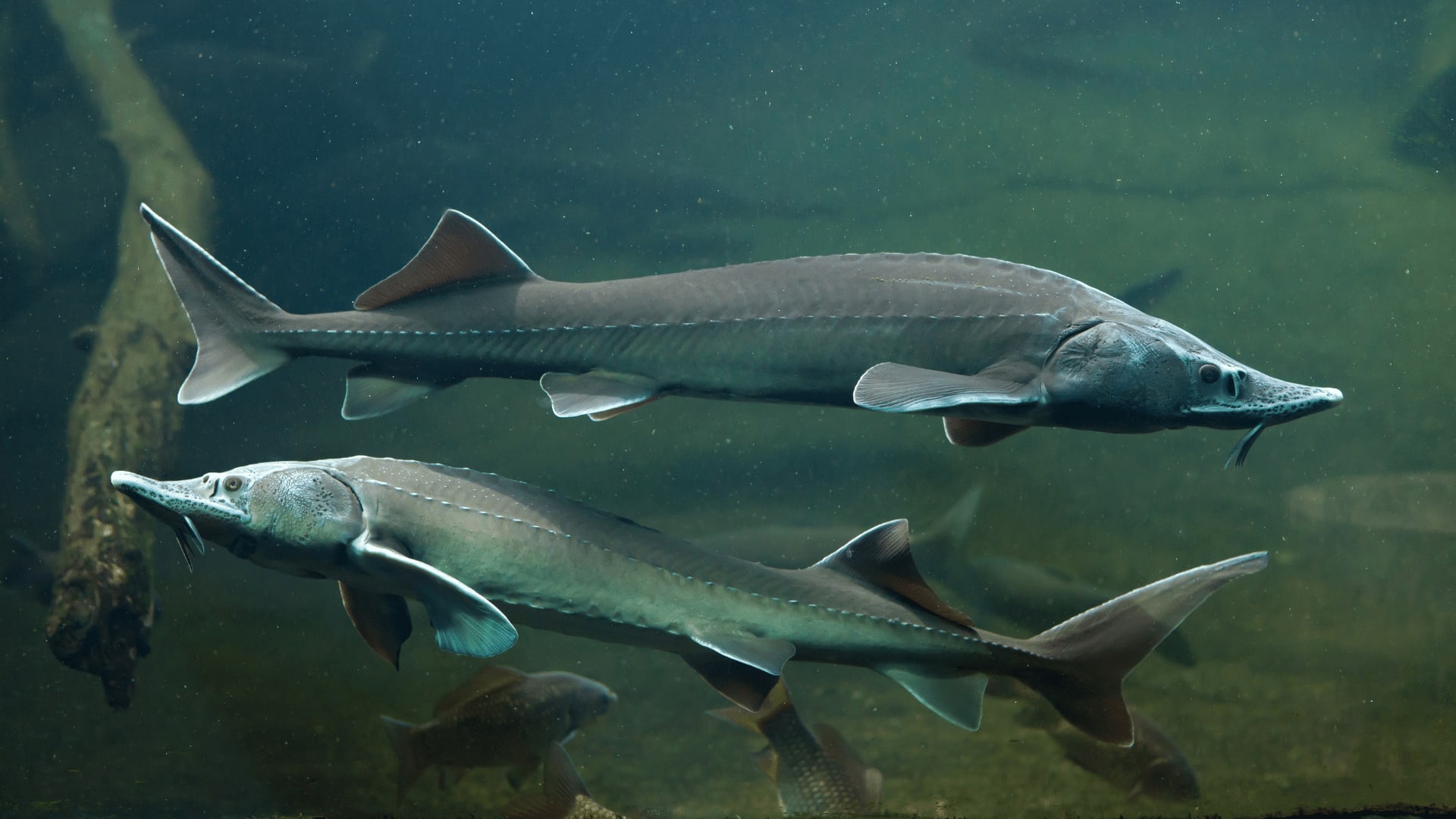
The Sturgeon is an anadromous species that spends most of its life in the water but breeds in freshwater. It lives at the bottom of the sea in depths up to 5 to 60 meters and feeds only on invertebrates, including small crustaceans, worms, and mollusks. When young, they migrate to the mouths of rivers around 4 or 5 months after being born and remain in estuaries for more than a year. It is a large species that can reach 350 cm in total length and 300 kg and can live up to a hundred years. The sea sturgeon’s body is elongated and scaleless, with small denticles and five rows of bony plates. It also has four barbels and a very prominent snout, and its back can be brown or dark gray, but it’s paler on the sides with a white belly.
The maximum length ever described was that of a male that reached 5 meters and a maximum weight of 400 kg.
They were primarily found in the Iberian Peninsula in the Tagus, Ebro, and Guadalquivir rivers back in the 19th century and sold in Lisbon, Tortosa, and Seville markets. Nowadays, it is also found in the Miño, Duero, Guadiana, Júcar, and Turia rivers while surviving the longest in the Guadalquivir. Its main threat is accidental catches of the species. At the same time, the leading causes of its decline have been the regulation of riverbeds, the decrease in flows, the construction of dams, pollution, and the extraction of aggregates in spawning areas.
I have yet to say it, but you might have wondered if the Sturgeon was somehow related to Caviar all this time. And it is!! The Sturgeon is captured with nets, raised in hatcheries, and when they reach the fertile age, they are artificially inseminated to extract their eggs later. There are several types of Caviar, and the best known are Beluga, Osetra, and Sevruga. In Spain, two areas are being repopulated with Sturgeon, the waters of the Riofrío in Granada, with the Acipenser Nacarii species, native to the Guadalquivir, and in Les, in the heart of the Arán Valley with the species Acipenser Baeri.
During spring, the spawning season for this species, we can see it approaching the coasts to enter freshwater rivers, where they look for calm, warm areas with a muddy bottom (their favorite places to lay their eggs). After this spawning, the Sturgeon will return to the sea, while the young specimens remain in this fresh water for approximately one year.
11. Bearded Vulture, Quebrantahuesos
Gypaetus barbatus
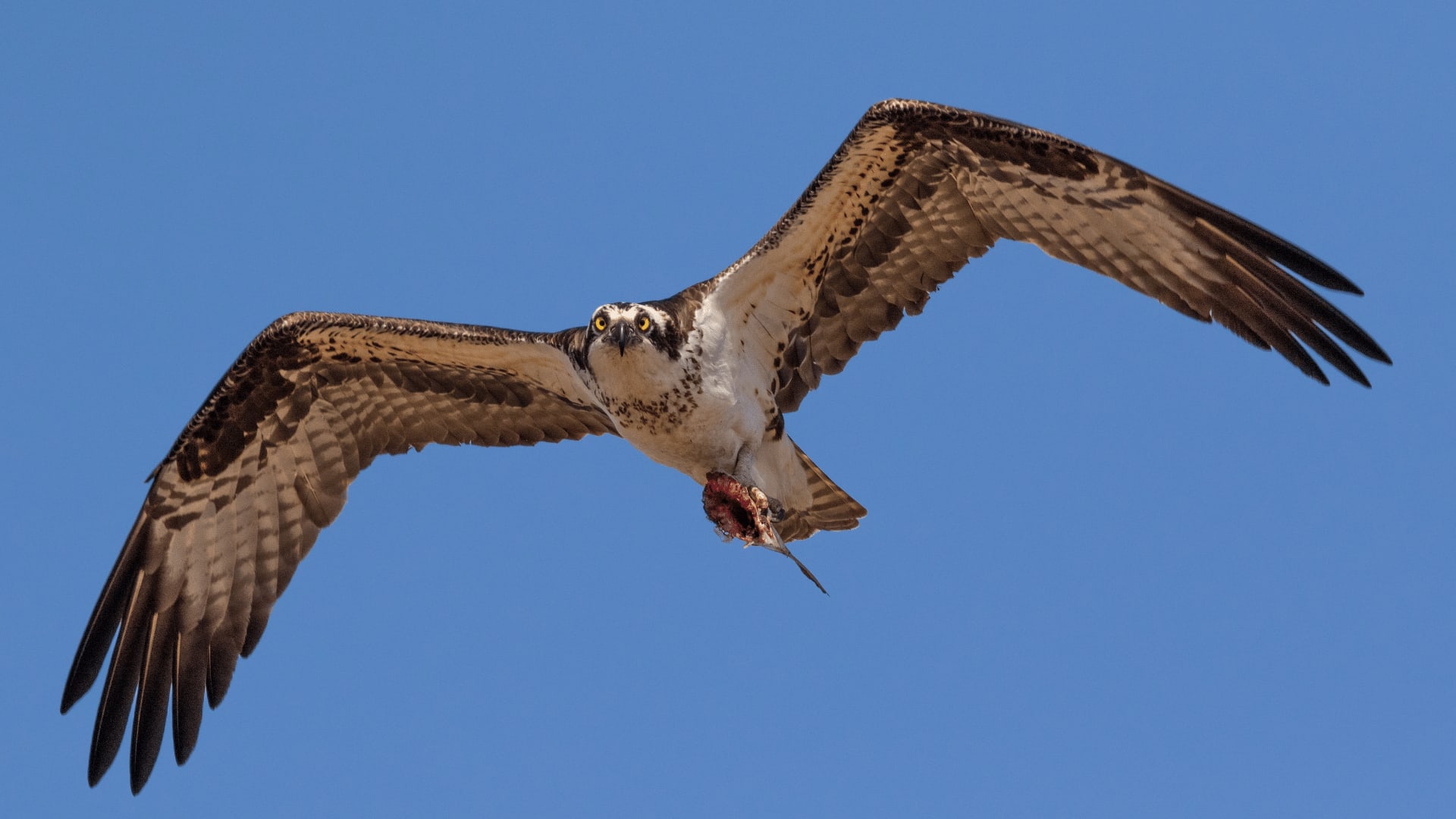
The truth is that we are all impressed to see the majestic flight of the bearded vulture flying in some corner of the Pyrenees. The breaded vulture is a remarkably different vulture from other similar birds of prey. It can measure 2.80 m and weigh 7 kg. It requires large mountainous systems with abundant steep walls equipped with cavities, caves, and cliffs, where it can nest without being disturbed. Its surrounding fauna also influences the extent and location of its habitat, being found in the same geographical area and biotopes as the goats.
It was classified as an “Endangered Species” in the National Catalog of Endangered Species in 1990. While in the European continent, it is an animal in serious danger of extinction that has disappeared from several regions where it was previously abundant. Today it can be seen in the Cantabrian Mountains, the Pyrenees, the Alps, and North Africa.
Typically, the bearded vulture is at the last link in the food chain since it exploits bones from corpses once used by corvids, kites, vultures, and carnivorous mammals. Their diet comprises 70% bones, 25% meat, and 5% skin.
The Bearded Volture is the only bird that feeds almost exclusively on bones.
It is unusual for the bearded vulture to make any sound, but if threatened, the breaded vulture can emit a small whistle. Still, this species usually communicates with its eyes and head plumage.
The primary cause of mortality in bearded vultures is associated with the illegal use of poisoned baits, seriously compromising the growth of the Spanish population and its colonization process in new areas. The second cause is death by collision or electrocution after incidents related to power lines found in mountain areas close to hills or slopes of medium and high altitudes, as they are places of frequent passage. And lastly, we have illegal hunting and loss of habitat due to the construction of large infrastructures in mountain areas or related activities.
Spain is home to a large number bird species and is an ideal bird-watching destination, I have a whole article dedicated to birds in which I listed the 100 most watched birds by Spaniards!! Check them out in this article:
As you can see, our fauna and biodiversity are very rich and impressive. Hope to see you at Sierra de Gredos looking for some Mountain Goats anytime soon… but most importantly, remember that awareness is, therefore, the most vital piece that favors the conservation of all these species after all.



